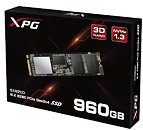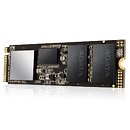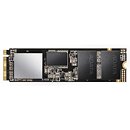Thursday, March 22nd 2018

ADATA XPG launches the Gaming SX8200 PCIe M.2 2280 SSD
ADATA Technology, a leading manufacturer of high performance DRAM modules and NAND Flash products, today launched the XPG SX8200, its fastest consumer SSD to date. It arrives in a compact M.2 2280 form factor and uses the ultra-fast PCIe3x4 interface to deliver up to 3200MB/s read and 1700MB/s write - which is perfect for gamers, overclockers, and PC DIY enthusiasts in pursuit of unsurpassed performance! SX8200 employs the latest 2nd generation 64-layer 3D NAND Flash for improved reliability and ships in capacities of 240GB, 480GB, and 960GB.PCIe Gen3x4 - Breakthrough the Barrier of Speed
Leveraging ultra-fast PCIe Gen3x4 interface and the NVMe 1.3 protocol, the SX8200 provides tremendous improvement in read/write performance. It implements a 32bit DRAM data bus, intelligent SLC Caching, and a DRAM cache buffer, accelerating sequential and 4K random read/write speeds. It reaches speeds of up to 3200MB/s for reads and 1700MB/s for writes and 310K/280K IOPS random 4K read/writes for faster boot, shorter game loads, and system response time.
Multiple Data Protection Technologies for Greater Reliability
Utilizing 2nd generation 64-layer 3D NAND Flash, SX8200 is more reliable, faster performing, and longer lasting than ever. It also supports RAID Engine and Data Shaping for greater reliability and stability. Similarly, it has a 2 million hour MTBF (mean time between failures) rating. The SX8200 supports LDPC (low density parity check) error correcting code and wear leveling, among other fidelity-enhancing features.More Options for Gamers and Professionals
The high speeds and tolerances of the SX8200 make it a great choice for speed-seeking gamers, overclockers, and professionals, such as graphics/render artists and compositors. Customers can choose between the 240GB, 480GB, and 960GB versions of the SX8200. Additionally, the retail package includes a stylish black heat spreader with the XPG logo that users can opt to DIY install on the SX8200 quickly and easily. Like all XPG SSDs, the SX8200 is backed by an extended 5-year warranty as befits its premium quality.
Leveraging ultra-fast PCIe Gen3x4 interface and the NVMe 1.3 protocol, the SX8200 provides tremendous improvement in read/write performance. It implements a 32bit DRAM data bus, intelligent SLC Caching, and a DRAM cache buffer, accelerating sequential and 4K random read/write speeds. It reaches speeds of up to 3200MB/s for reads and 1700MB/s for writes and 310K/280K IOPS random 4K read/writes for faster boot, shorter game loads, and system response time.
Multiple Data Protection Technologies for Greater Reliability
Utilizing 2nd generation 64-layer 3D NAND Flash, SX8200 is more reliable, faster performing, and longer lasting than ever. It also supports RAID Engine and Data Shaping for greater reliability and stability. Similarly, it has a 2 million hour MTBF (mean time between failures) rating. The SX8200 supports LDPC (low density parity check) error correcting code and wear leveling, among other fidelity-enhancing features.More Options for Gamers and Professionals
The high speeds and tolerances of the SX8200 make it a great choice for speed-seeking gamers, overclockers, and professionals, such as graphics/render artists and compositors. Customers can choose between the 240GB, 480GB, and 960GB versions of the SX8200. Additionally, the retail package includes a stylish black heat spreader with the XPG logo that users can opt to DIY install on the SX8200 quickly and easily. Like all XPG SSDs, the SX8200 is backed by an extended 5-year warranty as befits its premium quality.



7 Comments on ADATA XPG launches the Gaming SX8200 PCIe M.2 2280 SSD
www.xpg.com/en/specification/547
Have a bit mixed feelings on this to be honest: Comparing to XPG-SX8000 MLC -> TLC, but yeah at least warranty is the same 5 Years. So should be solid ssd for future builds(hrhrhrh, could not resist).
Anyway, it appears that the sm2262 is the 2nd best controller SMI has and the 2262EN is the speed demon of all speed demons.
"Enterprise" speeds, someone is saying. OK, so, it is 3D TLC, which is an improvement, over MLC (speed and endurance).
So, what's the catch? Is it just that ADATA is a dog? Is Micron somehow flawed?
Why is this bad? And can you explain it to someone as daff as me?